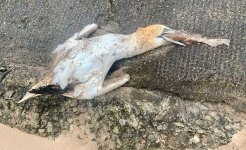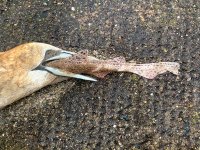
That is a gorgeous picture!!!



Dog fish by the looks of itI went to Irvine today. When I left home it was overcast and it looked like it would rain, but it actually hadn't rained for the full trip there - until we got to Irvine! It rained lightly on and off but it was very windy and stormy and the sea was looking really rough. I don't go to the coast often enough to see a stormy sea so this was an attraction on its own.
A walk from the station the beach brought me lots of Canada Geese, 11 Oystercatchers, a couple of Curlew, 23 Redshank, a single Eider and Goosander, lots of Mute Swans, including the first I think I've ever seen gliding as it came in to land facing the wind, a couple of Cormorants, lots of Starlings and quite a few Pied Wagtails in different plumages.
I spent a few minutes at the beach admiring the waves and I was then planning to walk down over the top the dunes. At this point it was dry but still windy, but then all of a sudden out of nowhere we were hit with ALL of Saturday's rain in one go. I got thoroughly soaked. There was a silver lining though. As I stood behind a building to shelter from the rain, I saw a Merlin flash by. Pretty certain I would not have seen this if I'd continued on my walk.
At the beach I found this dead Gannet with what I think is a fish (catshark? dogfish?) in its bill. Presumably the bird had choked on the fish that was bigger than it could swallow?
View attachment 1572752
View attachment 1572753




Hopefully yours will turn up. They built artificial nests for them at Lochwinnoch but the birds never used them, preferring natural riverbanks nearby.I'm glad you've got Sand Martins over there - went to a Sand Martin breeding bank yesterday and not one to be seen.



